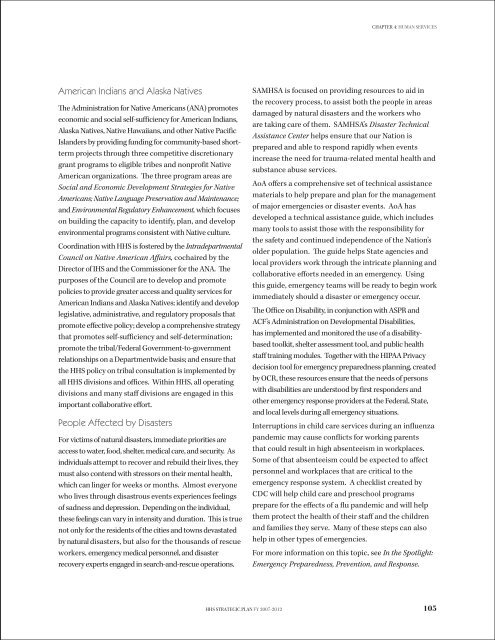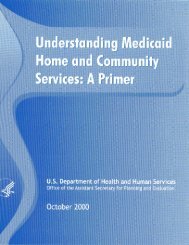STRATEGIC PLAN - ASPE - U.S. Department of Health and Human ...
STRATEGIC PLAN - ASPE - U.S. Department of Health and Human ...
STRATEGIC PLAN - ASPE - U.S. Department of Health and Human ...
Create successful ePaper yourself
Turn your PDF publications into a flip-book with our unique Google optimized e-Paper software.
CHAPTER 4: human servicesAmerican Indians <strong>and</strong> Alaska NativesThe Administration for Native Americans (ANA) promoteseconomic <strong>and</strong> social self-sufficiency for American Indians,Alaska Natives, Native Hawaiians, <strong>and</strong> other Native PacificIsl<strong>and</strong>ers by providing funding for community-based shorttermprojects through three competitive discretionarygrant programs to eligible tribes <strong>and</strong> nonpr<strong>of</strong>it NativeAmerican organizations. The three program areas areSocial <strong>and</strong> Economic Development Strategies for NativeAmericans; Native Language Preservation <strong>and</strong> Maintenance;<strong>and</strong> Environmental Regulatory Enhancement, which focuseson building the capacity to identify, plan, <strong>and</strong> developenvironmental programs consistent with Native culture.Coordination with HHS is fostered by the IntradepartmentalCouncil on Native American Affairs, cochaired by theDirector <strong>of</strong> IHS <strong>and</strong> the Commissioner for the ANA. Thepurposes <strong>of</strong> the Council are to develop <strong>and</strong> promotepolicies to provide greater access <strong>and</strong> quality services forAmerican Indians <strong>and</strong> Alaska Natives; identify <strong>and</strong> developlegislative, administrative, <strong>and</strong> regulatory proposals thatpromote effective policy; develop a comprehensive strategythat promotes self-sufficiency <strong>and</strong> self-determination;promote the tribal/Federal Government-to-governmentrelationships on a <strong>Department</strong>wide basis; <strong>and</strong> ensure thatthe HHS policy on tribal consultation is implemented byall HHS divisions <strong>and</strong> <strong>of</strong>fices. Within HHS, all operatingdivisions <strong>and</strong> many staff divisions are engaged in thisimportant collaborative effort.People Affected by DisastersFor victims <strong>of</strong> natural disasters, immediate priorities areaccess to water, food, shelter, medical care, <strong>and</strong> security. Asindividuals attempt to recover <strong>and</strong> rebuild their lives, theymust also contend with stressors on their mental health,which can linger for weeks or months. Almost everyonewho lives through disastrous events experiences feelings<strong>of</strong> sadness <strong>and</strong> depression. Depending on the individual,these feelings can vary in intensity <strong>and</strong> duration. This is truenot only for the residents <strong>of</strong> the cities <strong>and</strong> towns devastatedby natural disasters, but also for the thous<strong>and</strong>s <strong>of</strong> rescueworkers, emergency medical personnel, <strong>and</strong> disasterrecovery experts engaged in search-<strong>and</strong>-rescue operations.SAMHSA is focused on providing resources to aid inthe recovery process, to assist both the people in areasdamaged by natural disasters <strong>and</strong> the workers whoare taking care <strong>of</strong> them. SAMHSA’s Disaster TechnicalAssistance Center helps ensure that our Nation isprepared <strong>and</strong> able to respond rapidly when eventsincrease the need for trauma-related mental health <strong>and</strong>substance abuse services.AoA <strong>of</strong>fers a comprehensive set <strong>of</strong> technical assistancematerials to help prepare <strong>and</strong> plan for the management<strong>of</strong> major emergencies or disaster events. AoA hasdeveloped a technical assistance guide, which includesmany tools to assist those with the responsibility forthe safety <strong>and</strong> continued independence <strong>of</strong> the Nation’solder population. The guide helps State agencies <strong>and</strong>local providers work through the intricate planning <strong>and</strong>collaborative efforts needed in an emergency. Usingthis guide, emergency teams will be ready to begin workimmediately should a disaster or emergency occur.The Office on Disability, in conjunction with ASPR <strong>and</strong>ACF’s Administration on Developmental Disabilities,has implemented <strong>and</strong> monitored the use <strong>of</strong> a disabilitybasedtoolkit, shelter assessment tool, <strong>and</strong> public healthstaff training modules. Together with the HIPAA Privacydecision tool for emergency preparedness planning, createdby OCR, these resources ensure that the needs <strong>of</strong> personswith disabilities are understood by first responders <strong>and</strong>other emergency response providers at the Federal, State,<strong>and</strong> local levels during all emergency situations.Interruptions in child care services during an influenzap<strong>and</strong>emic may cause conflicts for working parentsthat could result in high absenteeism in workplaces.Some <strong>of</strong> that absenteeism could be expected to affectpersonnel <strong>and</strong> workplaces that are critical to theemergency response system. A checklist created byCDC will help child care <strong>and</strong> preschool programsprepare for the effects <strong>of</strong> a flu p<strong>and</strong>emic <strong>and</strong> will helpthem protect the health <strong>of</strong> their staff <strong>and</strong> the children<strong>and</strong> families they serve. Many <strong>of</strong> these steps can alsohelp in other types <strong>of</strong> emergencies.For more information on this topic, see In the Spotlight:Emergency Preparedness, Prevention, <strong>and</strong> Response.HHS Strategic Plan FY 2007-2012105
















